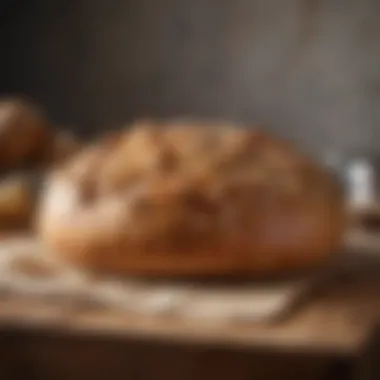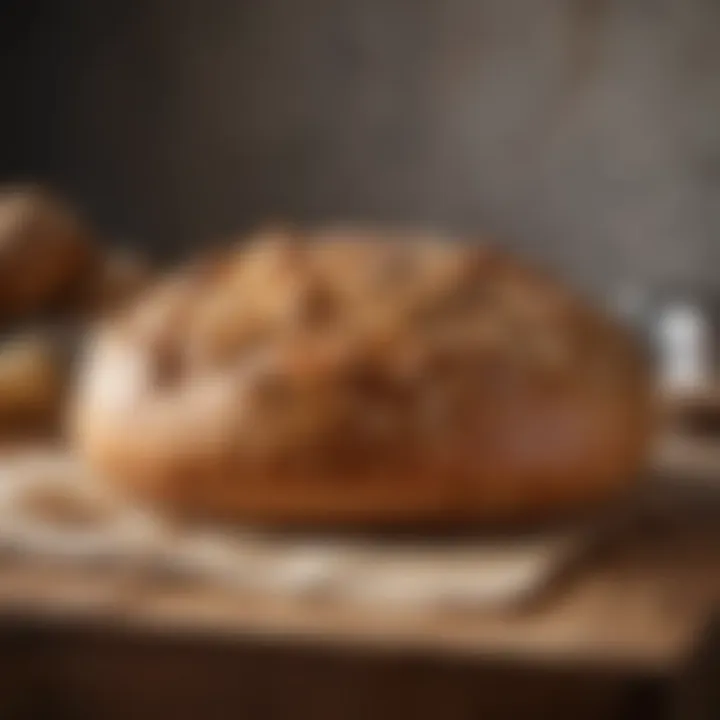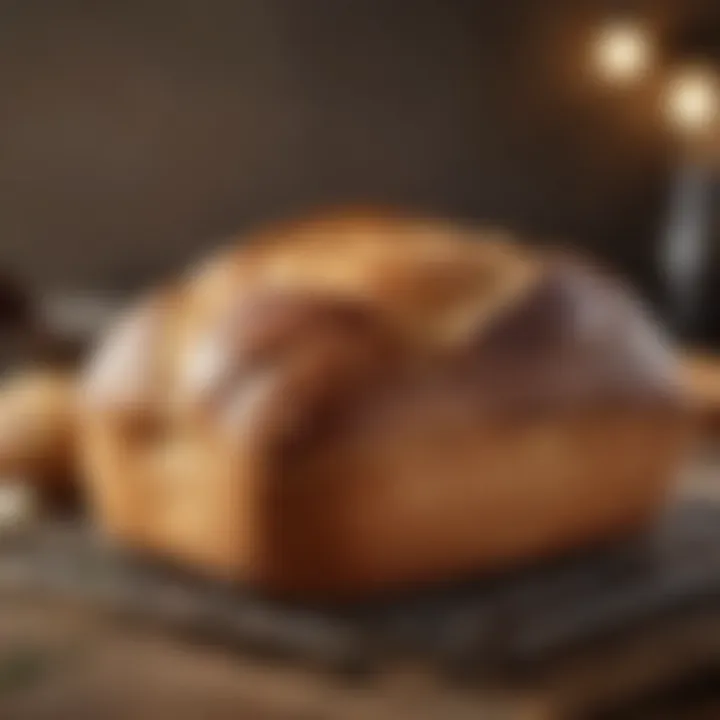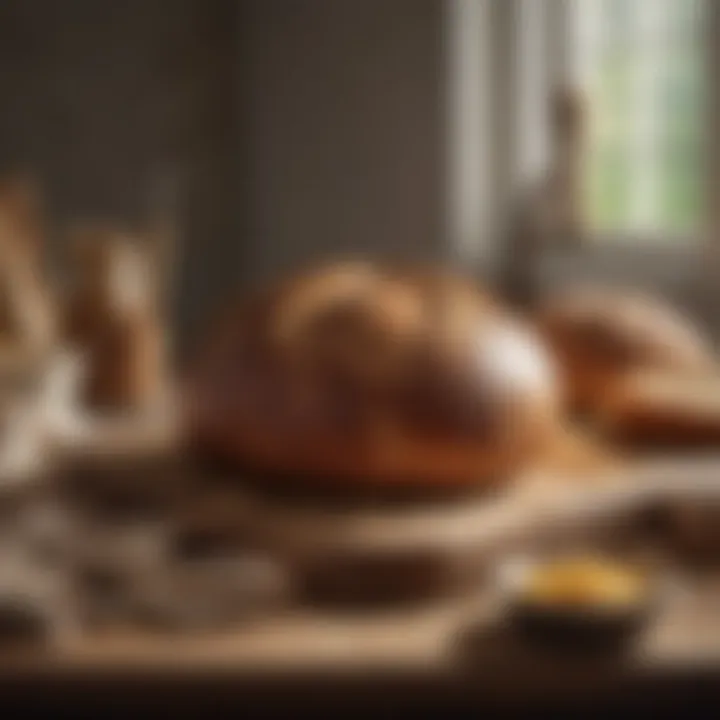Mastering Home Bread Making: A Complete Guide


Intro
Bread making at home is an age-old tradition enjoyed by many. It's more than just mixing ingredients; it’s an experience steeped in history, culture, and, truth be told, quite a bit of joy. Whether you’re standing at the kitchen counter for the first time or you’ve been kneading dough since you could reach the countertop, crafting your own bread can be both rewarding and therapeutic.
The act of baking bread can feel like a warm hug on a chilly day. In today's fast-paced world, the simple act of creating something from scratch, coupled with the inviting aroma of fresh bread wafting through the home, is a welcome escape.
Before diving into the nitty-gritty of various recipes and techniques, it’s essential to grasp the essentials of bread making. This guide aims to carve out a clear path for both novices and adept bakers alike, blending fundamental knowledge with a touch of creativity.
In the sections that follow, we will explore a comprehensive overview of recipes, a detailed ingredients list that underpins your baking, and the techniques necessary for perfecting that crusty loaf. We’ll also touch upon the common pitfalls one might encounter, offering solutions to keep your bread dreams intact. After all, not every loaf is a masterpiece at first.
Let’s roll up our sleeves and embark on this bread-making journey together.
Prelude to Homemade Bread
Baking bread at home isn't just about whipping up a loaf to fill your stomach; it's a journey into tradition, patience, and creativity. When you master the art of homemade bread, you unlock a door to numerous benefits that extend beyond the taste of your culinary efforts. The feel of warm dough in your hands, the nostalgic scent wafting through your kitchen, and the satisfaction of tearing into a fresh loaf all contribute to the allure of this culinary craft.
Making bread at home means you control the ingredients. Skipping the preservatives and fillers often found in store-bought varieties can lead not only to healthier choices but also allows for customization to suit personal dietary needs. From gluten-free options to incorporating grains like spelt or rye, the possibilities are endless. You can explore flavors by adding herbs, nuts, or seeds to your basic bread dough, catering to your taste and preference.
Additionally, the process of bread-making can be therapeutic. Kneading the dough can serve as a form of exercise and stress relief. The rhythmic motions, the transformation of simple ingredients into something nourishing and delightful—there's magic in the act itself. Each batch of dough becomes a canvas for your creativity.
However, embarking on home bread-making does require a commitment to learning. Understanding how various ingredients influence the outcome and practicing techniques takes time and practice. But once you start, it can be incredibly rewarding, bringing not only a sense of achievement but an unmatched aroma that fills your home.
"Bread is the staff of life."
This simple saying encapsulates the notion that bread has been a staple of human nourishment for thousands of years, linking us to countless generations.
In this section, we will delve further into why homemade bread captures the heart of many and explore the historical context surrounding its creation. Understanding how bread has evolved can deepen our appreciation for what we create today.
Understanding Basic Ingredients
Grasping the fundamentals of ingredients is crucial for anyone looking to perfect the craft of homemade bread. Each component plays a pivotal role in the texture, flavor, and overall success of your loaf. A thoughtful selection of ingredients can transform a simple recipe into an extraordinary culinary creation. Often, the nuances of how different elements interact can make or break your bread-making venture.
Flour Types and Their Properties
Understanding the types of flour is akin to choosing the right canvas for a painting. They each come with unique characteristics that influence the final product.
All-Purpose Flour
All-purpose flour is possibly the most versatile flour you'll encounter in a home baker's kitchen. It's made from a blend of hard and soft wheat, resulting in a balanced protein content of around 10-12%. This characteristic makes it suitable for a variety of recipes, from bread to pastries. The flexibility of all-purpose flour allows it to contribute to a tender crumb while still providing ample structure. However, its drawback lies in its adaptability; for those seeking specific textures in artisanal bread, this flour may sometimes fall short.
Whole Wheat Flour
Whole wheat flour is another essential player in the baking field, prized for its nuttier flavor and higher nutritional value compared to all-purpose flour. It retains the bran and germ from wheat grains, leading to a denser loaf with more fiber. This flour can be a beneficial choice for those striving for healthier options. However, due to its high protein content, whole wheat flour often requires more hydration and adjustments in recipes. Adapting when using it can be a bit of a learning curve, but the wholesome taste it imparts is well worth the effort.
Sourdough Starter
Sourdough starter is no ordinary ingredient; it's a living community of yeast and bacteria that contributes to both flavor and leavening. This natural leavening agent ferments the dough, creating a unique tangy taste while also improving texture. The key characteristic of a sourdough starter is that it is completely organic. However, it requires a commitment to maintain, as it needs regular feedings and attention. For traditionalists or those wanting an authentic bread experience, this option provides a fascinating journey into the science of fermentation.
Role of Yeast in Bread Fermentation
Yeast is the unsung hero in the world of bread-making, taking center stage in the process of fermentation. It’s critical for leavening bread, helping it rise and creating the delightful porous texture. Grasping the differences between the various types of yeast can enhance your baking experience.
Instant Yeast vs. Active Dry Yeast
When it comes to yeast, you'll typically encounter instant yeast and active dry yeast. Instant yeast is a power-packed version; it doesn’t require proofing before being added to the dry ingredients, speeding up the overall process. Active dry yeast, on the other hand, necessitates a bit of planning as it has to be dissolved in warm water prior to incorporating it into the mix. Both work well in home baking, but knowing which to use can make a big difference in convenience and results. The choice often boils down to personal preference regarding timing and ease of use.
Natural Leavening Agents
Natural leavening agents, such as sourdough starters, can also be a fantastic choice for seasoned bakers. These agents not only act as leavening robots but also offer a depth of flavor that store-bought yeast simply can’t match. Moreover, engaging with natural fermentation can connect you more deeply with the craft of baking. However, patience is paramount here, as the process can be lengthy compared to commercial yeasts.
Water and Its Impact on Dough
Water plays a more significant role in the dough than one might think. It hydrates flour, activating the gluten, which gives bread its structure and chewiness. The quality and temperature of water can also affect the yeast, influencing fermentation. It works harmoniously to create an enticing balance between moisture and elasticity.
Essential Additives: Salt and Sugar
Salt is a crucial ingredient that enhances flavor while also strengthening gluten structure. It regulates yeast fermentation and ultimately contributes to the bread's overall character. Sugar, on the other hand, serves as food for yeast, encouraging it to ferment and rise. It also caramelizes during baking, providing that golden crust. Both these elements complement each other, playing fundamental roles in the fascinating process of bread-making.
"Understanding these basic ingredients and their roles is the first step towards mastering the art of bread making, opening a world of flavors and textures that you can create at home."
By delving deep into the unique properties of each ingredient, you can elevate your baking game significantly, creating loaves that aren't just good, but truly extraordinary.
Necessary Tools for Baking Bread
When it comes to baking bread at home, having the right tools makes a world of difference. Each piece of equipment plays a crucial role in achieving that perfect loaf. From mixing to baking, the tools you use can enhance the ease and quality of your bread-making experience. Let’s take a closer look at what’s essential to get started and what can elevate your baking.


Essential Baking Equipment
Mixing Bowls
Mixing bowls are not just any old vessels; they form the heart of your baking process. Ideally, you want a bowl that is sturdy, easy to handle, and large enough to accommodate your dough as it rises. Typically, stainless steel bowls are favored due to their durability and ease of cleaning. They also don’t retain odor or stain easily.
However, a glass bowl can be beneficial since you can see the dough rise. It also holds the heat well, which aids in fermentation. But watch out! They can be heavier and might break if not handled carefully.
Overall, a good mixing bowl is a worthwhile investment, allowing for proper mixing and rising of the dough, setting the stage for a successful bake.
Measuring Tools
Accurate measurements can be the difference between a loaf that rises beautifully and one that falls flat. That's where measuring tools come into play. You’ll want a reliable set of measuring cups and spoons, preferably with clear markings for accuracy. A liquid measuring cup is also essential for water and milk. It’s often made of glass or plastic, with a pour spout for convenience.
Digital kitchen scales can take your measuring game to the next level. They provide precise measurements, especially important when dealing with ingredients like flour that can vary in weight. The downside is that you need to be comfortable with weighing rather than measuring, which might take some getting used to, especially for beginner bakers.
Ovens and Baking Stones
The oven is where the magic happens. A good oven is vital because it provides the controlled environment needed for your bread to rise and bake evenly. Some bakers opt for baking stones—these create a hot, even surface that helps achieve a crispy crust while also retaining moisture, ideal for artisan breads.
If you’re considering a baking stone, be sure to preheat it well ahead of time. Its unique feature enhances heat retention, but it can be heavy and may require extra care in handling. Also, if your home oven tends to have hot spots, invest in an oven thermometer to keep track of the temperature accurately.
Optional Tools to Enhance Experience
While the essential tools get the job done, several optional tools can add convenience and improve your bread-making journey.
Bread Machines
For those who prefer a more hands-off approach, bread machines are a popular choice. They handle everything from mixing to baking, which can save you considerable time. The key characteristic of a bread machine is its ability to automate the process, making it perfect for busy individuals or those just starting out.
But keep in mind that a bread machine won’t give the same artisanal crust you achieve with oven baking. The downside here is the limited ability to customize recipes compared to traditional methods. However, if you're looking for convenience, it might just fit the bill.
Kitchen Scales
Scales stand alongside measuring tools in importance, especially for bread-making precision. The unique feature of kitchen scales is the ability to measure ingredients by weight rather than volume. This can lead to more consistent results, particularly with flour, which can compact and result in inaccurate readings.
The downside to using a scale is that it may feel cumbersome for those used to cup measurements. But once mastered, it sure pays off in the quality of your bread.
Proofing Baskets
Proofing baskets, also known as banneton, are not only functional but can also add an aesthetic touch to your process. These baskets hold the dough as it rises for the second time, giving it a distinctive shape and helping to maintain its structure. The unique feature of proofing baskets is that they allow for proper moisture release during rising, which is critical to developing a nice crust.
However, they can be a bit of a niche item. Not everyone sees the need for them, especially if using bowls works just as well. So, while not strictly necessary, they may offer benefits worth considering.
The right tools can turn baking from a chore to a rewarding experience. Don’t underestimate their impact!
Basic Bread Recipe
The bedrock of bread making lies in the basic bread recipe, a critical component that sets the stage for all subsequent baking endeavors. This pivotal section encompasses the fundamental aspects of crafting bread at home, making it not only a stepping stone for beginners but also a reliable reference for seasoned bakers revisiting the simple pleasures of bread creation. The significance here stretches beyond just achieving a loaf; it’s about understanding the intricate dance between the various elements of bread-making and how they coalesce to create a satisfying product.
Gathering Ingredients
When it comes to gathering ingredients, understanding each component's role is paramount. Bread, at its core, consists of a few vital players:
- Flour: The star of the show. Different types of flour contribute unique textures and flavors. For instance, all-purpose flour provides versatility, while whole wheat flour offers a heartier, nuttier profile.
- Water: Essential for hydration, water activates the gluten in the flour, allowing for rise and structure.
- Yeast: Whether you choose instant or active dry yeast, this ingredient works wonders, fermenting the dough and helping it to expand.
- Salt: This isn't just for flavor; it also regulates yeast activity and strengthens the gluten.
- Sugar: While optional, it can enhance flavor and boost yeast's effectiveness, leading to a better rise.
Gather these ingredients in measured quantities, and you are well on your way to a successful loaf.
Mixing and Kneading Dough
Once the ingredients are at hand, it’s time to mix them. Start by combining the dry ingredients first: flour, yeast, salt, and sugar. Make a well in the center and pour in the water. Mix gently until a shaggy dough forms. This initial mixing phase is crucial for ensuring that the yeast and salt are evenly distributed.
Next comes the kneading process. Kneading isn’t just about working out the dough; it’s about developing the glutens that give bread its structure. Knead for approximately 10 minutes, folding and stretching the dough until it becomes smooth and elastic. You should feel a distinct change in texture during this period, which indicates that the gluten is forming.
First Rise: Importance and Technique
The first rise, often referred to as bulk fermentation, is where the magic happens. This is not merely a waiting game; it’s a vital step for enhancing flavor and texture. During this time, the yeast consumes sugars and produces carbon dioxide and alcohol, leading to a rise in the dough.
- Technique: Place the kneaded dough in a lightly oiled bowl and cover it with a damp cloth or plastic wrap. Aim for a warm environment, about 75-80°F (24-27°C), to speed up fermentation. You should allow the dough to rise until it has doubled in size; this can take anywhere from one to two hours, depending on ambient temperature.
Shaping and Second Rise
After achieving that initial rise, it's time to shape your dough. This step is where creativity can shine. Gently deflate the dough and turn it out onto a lightly floured surface. Determine what type of loaf you want. For instance, a standard round or a classic baguette shape are both options worth considering.
- Shaping Tips: Ensure the shaping is tight enough to hold the dough together without compressing it too severely, which could affect the rise. Once shaped, place it in a proofing basket or directly on a baking tray, depending on your preferences.


This stage is followed by a second rise, also referred to as proofing. The dough should rest for about 30-45 minutes and is typically covered to prevent drying.
"Baking is about patience; let the dough do its thing, and it will reward you with a glorious crust and tender crumb."
Embracing the nuances of these processes makes all the difference. It’s through gathering, mixing, rising, shaping, and waiting that one begins to uncover the art form that is bread making.
Baking Techniques
Baking techniques encompass the essential methods and strategies used to transform raw dough into that golden-brown, crusty loaf that many aspire to achieve. Understanding these techniques is like having the roadmap to a culinary treasure; every twist and turn can lead you to a delightful treat or a hefty misstep. Precision in the baking process directly affects the texture, flavor, and overall quality of the bread. Mastering these techniques is crucial for any bread maker, as they can significantly enhance the effectiveness of your baking and ultimately lead to a more satisfying loaf.
Optimal Oven Temperature
Oven temperature plays a pivotal role in bread baking. An adequately preheated oven allows for proper oven spring, which is the rapid rise of dough in the first minutes of baking. Ideally, most yeast breads bake well between 375°F to 475°F (190°C to 246°C), depending on the recipe.
Just imagine: you’ve spent hours kneading, proving, and shaping your dough, only to stick it in an oven that's not hot enough. The result? A flat loaf that’s dense rather than airy. Often overlooked, the importance of a reliable kitchen thermometer becomes clear here. When baking, it’s wise to invest in a good thermometer to ensure you hit the sweet spot for temperature.
- Hotter isn’t always better. Each bread type has its sweet spot; for instance, artisan sourdough is generally baked at a higher temperature to achieve that perfect oven spring.
- If you’re uncertain, err on the side of caution – it’s easier to adjust the temperature as you become more comfortable with your bread baking.
"The science of baking hinges not only on quality ingredients but also on the temperature control achieved during the process."
Using Steam for Crust Development
Steam is one of those elusive tricks that can turn a blah loaf into something spectacular. Introducing steam in the first phase of baking plays a crucial role in developing a thicker, crisper outer crust. This moisture allows the bread dough to expand more freely in the oven before the crust sets, resulting in a delightful contrast between the crunchy exterior and soft interior.
Here are a couple of approaches you can try:
- Place a pan of hot water in the oven while baking. This method is easy and effective, creating a humid environment in the oven.
- Spritz the dough with water before placing it in the oven. A few spritzes can work wonders.
Be mindful though, too much moisture can lead to undesired results, causing the crust to become soggy instead of crisp.
How to Tell When Bread Is Done
Determining the perfection of your loaf involves a bit of finesse and practice. The appearance of the crust, the sound when you thump it, and even the internal temperature play integral roles in this final assessment.
- Color: A well-baked loaf will have a deep golden-brown color. Anything on the lighter side may need more time.
- Thump Test: Gently tap the bottom of the loaf. If it sounds hollow, it’s likely done. If it’s dull, let it bake a little longer.
- Thermometer Check: Take the internal temperature of the bread. For most loaves, a reading of around 190°F (88°C) indicates it’s ready.
The journey to mastering bread doesn’t end with simply mixing the ingredients. Each technique holds its own importance, pushing you a step closer to achieving that perfect loaf. Being meticulous in these areas will not only enhance your skills but also allow you to enjoy the predictability and excitement that comes with baking at home.
Troubleshooting Common Issues
Baking bread can be an immensely satisfying endeavor, but it doesn’t always go off without a hitch. Mastering the art of bread making entails a learning journey where disappointments can crop up from time to time. Identifying and fixing common issues not only saves time and ingredients but also fine-tunes your skills. Understanding these challenges helps you troubleshoot effectively, allowing you to refine your technique and boost your confidence in the kitchen.
Dense or Heavy Bread
One of the most reported problems by home bakers is the creation of dense or heavy loaves. This can be frustrating, especially when you expect a light and airy crumb. There can be several culprits behind this issue:
- Insufficient kneading: Kneading isn't just a workout for your arms; it develops the gluten structure that provides bread its airy quality. Failing to knead adequately can lead to a loaf that doesn’t rise properly.
- Too much flour: Using more flour than necessary can result in overly dry dough that doesn’t have the elasticity needed to expand. It’s easy to over-measure if you scoop flour straight from the bag; instead, try spooning it into your measuring cup and leveling off.
- Yeast problems: If your yeast isn’t fresh, it may not provide enough lift. Ensure you're using yeast that is within its expiration date and consider proofing it in warm water with a bit of sugar to confirm it’s active.
"The key to fluffy bread lies not solely in the ingredients but in how well they are coaxed together."
If you encounter a dense loaf, don’t throw it out immediately. Use a bread knife to create croutons for soups or salads, and embrace the opportunity to learn and adjust your approach for the next bake.
Under or Over Baking
Another frequent issue is that of under or over baking bread. Both outcomes can affect the final quality of your loaf considerably. Here are a few pointers to help navigate this tricky terrain:
- Oven temperature: An oven that’s too hot can lead to a scorched crust while the inside remains unbaked. Conversely, a low temperature can prevent the bread from achieving a good rise and color. An oven thermometer can be an invaluable tool here.
- Baking time: Each recipe has a suggested baking time, but individual ovens can vary significantly. Always start with the recipe suggestion but adjust based on visual and tactile cues. The bread should sound hollow when tapped on the bottom and have a lovely golden color on top.
- Cooling time: Patience is key. Cutting into fresh bread too soon can lead to a gummy texture as the steam hasn't completely escaped. Let the bread cool on a wire rack.
In summary, troubleshooting common bread issues is an essential part of mastering home baking. It transforms setbacks into learning moments that enhance your baking prowess. Constantly experimenting and adapting is how you will improve your craft, one loaf at a time.
Exploring Different Types of Bread
Exploring various types of bread is crucial for bakers who seek to broaden their horizons and master the craft of bread-making. Each kind of bread has its unique characteristics, textures, and flavors, influenced by different ingredients and methods of preparation. Understanding these distinctions not only enhances one’s baking skills but also enriches the eating experience. Home bakers can create diverse offerings that cater to different tastes and preferences within their household and among friends. Each loaf tells a story and represents different cultures and culinary practices, making it more than just food; it becomes a canvas for creativity.
Artisan Breads and Their Characteristics
Artisan breads are often celebrated for their rustic appearance and complex flavors. Unlike standard loaves from the grocery store, these breads embrace traditional techniques, often using natural fermentation methods. The crust is usually thicker and crunchier, while the interior boasts an airy structure filled with irregular holes, a product of the long fermentation process.
When creating artisan bread, many bakers rely on high hydration doughs. This means that a larger proportion of water is used compared to flour. This moisture is key in developing the loaf's texture and flavor. Additionally, many artisan breads are baked in a steam-filled environment, which contributes to that delightful crust.
Some popular types of artisan bread include sourdough, ciabatta, and baguettes. Each has its specific method, but they are united by a respect for the ingredients and a patience in the process:
- Sourdough: Known for its tangy flavor, it uses wild yeast from the environment.
- Ciabatta: Characterized by its rustic crust and soft, ciabatta often requires gentle handling due to its wet dough.
- Baguettes: Long and slender, these breads are a staple in French cuisine, celebrated for their crisp crust and airy crumb.


*"Baking is both an art and a science; it allows for experimentation while adhering to the laws of nature."
Quick Breads Versus Yeast Breads
Quick breads and yeast breads differ fundamentally in their preparation and end results. Quick breads utilize baking powder or baking soda as leavening agents, which means they rise almost instantly. This category includes delightful options like banana bread, muffins, and pancakes.
In contrast, yeast breads rely on fermentation. The yeast not only contributes to the flavor and texture but also requires time for the dough to develop. This is why recipes for yeast breads often include rising times, allowing the flavor to deepen.
Here are some distinctions to consider:
- Quick Breads:
- Yeast Breads:
- Preparation: Straightforward mixing and baking; no rising time.
- Texture: Denser and moist; adaptable to include fruits, nuts, and spices.
- Uses: Perfect for a quick snack or brunch.
- Preparation: Involves kneading and multiple rise periods.
- Texture: Light and chewy, often with a crusty exterior.
- Uses: Ideal for sandwiches or rich accompaniments to meals.
Flatbreads: Techniques and Variations
Flatbreads are perhaps the most versatile category of bread. They come in various forms and can be found in nearly every culture. Unlike their leavened counterparts, flatbreads can be either unleavened or leavened slightly. Their unique cooking methods — often involving grilling or baking in a hot oven — lend to a distinctive flavor and texture.
Some well-known types of flatbreads include:
- Tortillas: Essential in Mexican cuisine, made from corn or wheat.
- Pita: Characteristically stuffed or used as a scoop for dips, originating from Middle Eastern regions.
- Naan: A soft, leavened bread from India, often cooked in a tandoor oven.
The process of making flatbread can be quite simple and rewarding. It can serve as a great introduction to those new to baking:
- Mix the Dough: Generally, just flour, water, and salt are needed.
- Roll it Out: Flatten it with a rolling pin to desired thickness.
- Cook: Use a skillet or oven to achieve a lightly charred surface, elevating its flavor profile.
Flavors can be enhanced through the addition of herbs, spices, or toppings. The end product is not just bread; it can be the foundation for wraps, sandwiches, or accompaniment to meals, showcasing the baker’s personal touch.
In summary, understanding and experimenting with different types of bread allows bakers to expand their repertoire, drawing inspiration from global traditions while applying their unique creativity. 🍞
Nutritional Aspects of Homemade Bread
When diving into the world of bread making, the nutritional benefits of homemade bread often come to the forefront. It’s not just about the love of baking; understanding what goes into your loaf can significantly impact your health and lifestyle choices. Bread is a staple in many diets, but how it’s made can alter its nutritional punch. This section explores the nuances that set homemade bread apart from its store-bought counterparts, shedding light on specific elements that can enhance one’s health.
Comparing Homemade Bread to Store-Bought
Purchasing bread off the shelf can certainly be convenient, but it comes with a tilt of uncertainty regarding the ingredients. One of the stand-out differences is the control you have over what goes into your loaf when you make it at home. Many commercial breads pack preservatives and additives, which can be a deterrent for health-conscious individuals.
- Ingredient Transparency: When baking at home, you are fully aware of everything that goes into your bread. You can choose organic flour, non-GMO ingredients, or even whole grains.
- Avoiding Artificial Additives: Many store-bought breads incorporate artificial yeast, high-fructose corn syrup, and other questionable substances, which can affect both the flavor and nutritional value.
- Customization of Nutrients: Homemade bread allows the incorporation of various seeds, nuts, or even nutritional enhancers, such as vital wheat gluten or flaxseed, which can boost fiber and protein levels in the bread.
"Homemade bread not only protects you from unknown additives but also provides countless opportunities to tailor nutrition to your specific dietary needs."
In a nutshell, opting for homemade bread can fortify your diet with wholesome ingredients that are hard to find in your usual supermarket options.
Understanding Ingredients and Health
The essence of homemade bread is deeply tied to its ingredients. Each component plays a crucial role in the bread's nutritional profile.
- Flour Types: Not all flours are born equal. White flour, while having a finer texture, often lacks the nutrients found in whole grain varieties. Whole wheat flour retains the bran and germ, making it richer in fiber, vitamins, and minerals.
- Yeast: The fermentation process of yeast is not just about rising; it also develops essential nutrients and probiotics that can aid digestion.
- Salt and Sugar: While they enhance flavor, the amount used needs careful consideration. Reducing added sugar and salt can create a heart-healthier bread while maintaining a satisfying taste.
- Add-ins: From oats to seeds, incorporating various ingredients can enrich the bread nutritionally. For instance, chia seeds offer omega-3 fatty acids, while nuts provide protein.
These points highlight that a little mindful choice goes a long way. The great thing about making your bread is how you can modify recipes to cater to your dietary restrictions or preferences. In doing so, you embrace a more tailored approach to health – one that can positively reflect in your overall well-being.
By taking a closer look at the ingredients, you not only promote better health but also enjoy breads that resonate with personal tastes and choices.
Finale: Embracing the Bread-Making Journey
Baking bread at home is an adventure, one that goes beyond mere consumption of food. Throughout the article, the countless steps and techniques discussed center on creating a personal connection with this age-old tradition. Bread making isn’t just about following a set recipe; it’s a meaningful process that celebrates everything from the selection of ingredients to the magic that happens in the oven.
When you finally pull a loaf out of your own oven, warm and fragrant, it’s more than just a meal—it’s a testament to your effort, your diligence, and perhaps even your artistic flair.
Every loaf holds within it the potential for creativity—every dusting of flour and kneading session can become a reflection of your unique style. Homemade bread also allows for experimentation and is forgiving enough to let you explore different flavors or methods without fear. A few tweaks in a recipe can lead to vibrant results, whether you’re adjusting the hydration ratio, fiddling with spices, or considering alternative grains.
The journey of bread making offers several benefits, not only nourishing the body but also feeding the soul. It provides a sense of accomplishment, fostering patience and mindfulness. After all, waiting for that dough to rise requires a level of dedication that, in our fast-paced world, can feel intimidating yet rewarding.
So, as you venture forth, remember that each loaf will teach you something new. When setbacks arise—from a dough that refuses to rise to a crust that has lost its crunch—embrace them as part of the experience. Each setback prepares you for the next loaf, and each successful bake encourages you to innovate further.
"Baking bread is about taking your time and learning from each experience."
Reflecting on the Art of Bread Making
Reflecting on your experiences in bread making is crucial for growth as a baker. Slow down and think about each phase—from gathering your ingredients to that moment of slicing into a freshly baked loaf. Ask yourself: What worked? What didn't? What flavors came together beautifully? Did the crust turn out as you envisioned it?
By keeping notes or maintaining a baking journal, you can trace patterns that lead to improvement. Over time, you can develop your own signature style, perhaps even stumbling upon favorite combinations or variations that resonate with your family and friends. Remember, there’s no right or wrong here, just different paths leading to delicious outcomes.
Encouraging Personal Creative Touches
Adding personal touches to your bread is what truly makes it yours. Don’t be afraid to swap in unusual ingredients—like herbs from your garden, nuts, or dried fruits—or to explore imaginative flavor pairings. Consider a rosemary bread, for example, where that fragrant herb shines through. Or a sun-dried tomato and olive loaf that transports your taste buds to a rustic Italian kitchen.
Moreover, presentation can also be a canvas for creativity. Practicing decorative scoring techniques or even trying your hand at different shapes can make you feel like an artist in the kitchen. Plus, sharing your homemade bread with loved ones can create memorable moments, each slice igniting conversations and connections.







